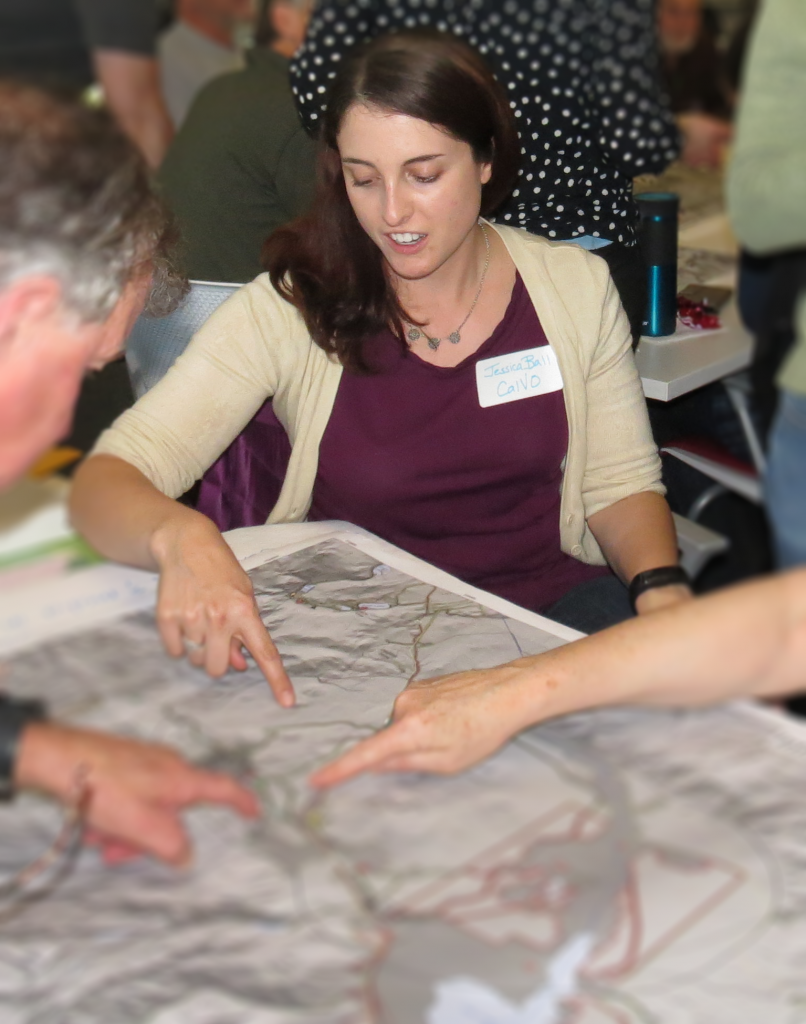2 February 2018
Rehearsing for eruptions
Posted by Jessica Ball
In the past few weeks, I’ve had the opportunity to help run several “tabletop” exercises with the USGS and our partners where we walk through a timeline of what might happen during a volcanic eruption, and ask participants to make decisions about how they would need to respond and work together. I find them both fascinating and exhausting – fascinating in that they’re a chance for me to see how people interact during an eruption response, and what priorities everyone has, and exhausting in that we’re condensing a response that might be weeks or months long into a single day of planning!

Co-leading a tabletop exercise at Lassen Volcanic National Park in northern California with my boss, Maggie Mangan.
The goals of a tabletop exercise change with who is participating. If it’s an internal one for the USGS volcano observatories, we concentrate on both our internal operations and how we would work with stakeholders (i.e., land and emergency managers, local officials, etc.). For outside groups, it’s an opportunity to grill us about what they would need from the science side of things in an eruption. This is an especially important part. Even though, say, the USGS and the National Park Service are both part of DOI, we don’t necessarily interact with each other often. Building relationships and plans before a crisis happens is crucial to working well together once we’re all under pressure and being forced to deal with complicated situations.
And wow, can those situations get complicated! Take one example: A volcano in a national park has an explosive eruption that creates pyroclastic flows, lahars (mudflows) and an ash plume that rises tens of thousands of feet into the air. The ground-based hazards are all contained within the park, but some of the mudflows reach land and roads under the jurisdiction of the Forest Service as well as a lake where there’s a fish hatchery and a lot of boat recreation. The ash rises far enough that it affects flight paths for air traffic. Suddenly you’re coordinating with the FAA, the NPS, the FS, maybe the Army Corps of Engineers, the Fish and Wildlife Service, not to mention local emergency responders and residents. You have to have consistent messaging when telling people about safety concerns, the scientists have to help the managers make decisions about what needs to be closed and who needs to be evacuated and for how long, and possibly advise first responders who have to make rescues, and everyone from local officials on up wants to be briefed on what’s going on and how long it will last.
Whew!

Tabletops often involve a lot of pointing at maps and arguing. Fortunately, geoscientists are good at both!
That’s a lot to think about. Add to that the fact that you might already have spent multiple weeks or months in crisis mode and heading for physical and emotional burnout, and it becomes apparent just how taxing these situations can be. That’s why tabletops are so important. You can rehearse for crises before they happen by developing roles and responsibilities and operational procedures, and inventorying resources and personnel.
California hasn’t had an eruption since 1917, and the last one was in a remote part of the state and didn’t affect many people. But the next eruption (and there will be one!) will have a ripple effect on the entire state. Our infrastructure and critical systems are much more complicated and widespread nowadays, and even if an eruption is remote and doesn’t directly affect anyone, it will almost certainly have impacts elsewhere. Rehearsing for the next eruption is crucial.
But on a more personal note, being in a gathering with people who have responded to eruptions before is a fantastic opportunity for me to soak up knowledge. I can read about past eruptions and how decisions were made, but having access to the people who made those decisions and hearing their thoughts is even more valuable. I’m still, compared to many of these people, a ‘baby’ volcanologist, and I haven’t been involved in an eruption response yet. Without that happening, my next best option is to learn from the folks who have been.
Of course, the best way to learn anything is by doing. Fortunately, working for a USGS volcano observatory puts me on the front lines, and the next time we have volcanic activity in this country that requires a response, I hope to be involved!


 Jessica Ball is a volcanologist at the U.S. Geological Survey, researching volcanic hydrothermal systems and stability, and doing science communication for the California Volcano Observatory. She previously worked at the Geological Society of America's Washington DC Policy Office, learning about the intersection of Earth science and legislative affairs. Her Mendenhall postdoc and PhD focused on how water affects the stability of volcanoes, and involved both field investigations and numerical modeling applications. Her blogging covers a range of topics, from her experiences in academic geosciences to science outreach and communication to her field and lab work in volcanology.
Jessica Ball is a volcanologist at the U.S. Geological Survey, researching volcanic hydrothermal systems and stability, and doing science communication for the California Volcano Observatory. She previously worked at the Geological Society of America's Washington DC Policy Office, learning about the intersection of Earth science and legislative affairs. Her Mendenhall postdoc and PhD focused on how water affects the stability of volcanoes, and involved both field investigations and numerical modeling applications. Her blogging covers a range of topics, from her experiences in academic geosciences to science outreach and communication to her field and lab work in volcanology.